How can PAD be prevented and treated?
Guard against PAD, a lifestyle-related disease that affects the feet and legs
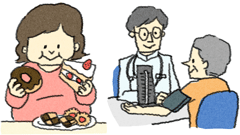
Risk factors for PAD include smoking, diabetes, high blood pressure, and high cholesterol, which predispose one to arteriosclerosis. That is why in guarding against PAD it is important to guard against or treat these health conditions, and if you are a smoker, to quit smoking.

It is also advisable to develop a habit of getting adequate exercise, such as walking in order to improve circulation in the feet and legs.
Four treatment approaches
There are four main treatment approaches for PAD: drug treatment, physical therapy, endovascular treatment and surgery including intravascular treatment.
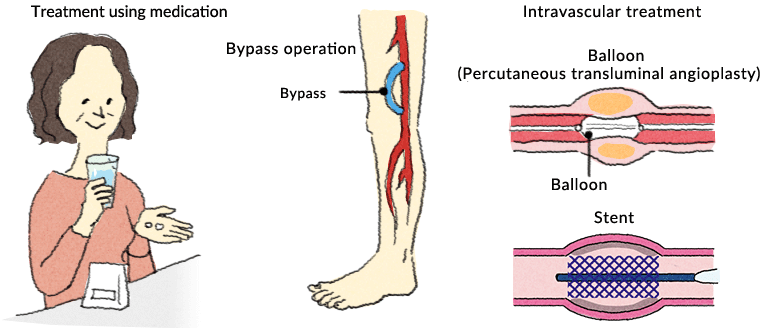
Treatment of PAD will initially focus on dealing with high blood pressure, diabetes, high cholesterol, or other diseases that tend to develop due to arteriosclerosis if any of those conditions are present.
At the same time, other treatments may be given according to the degree of progression of the disease and the condition of the patient. These treatments could be in the form of drugs such as anti-platelet agents and vasodilators, surgery to create a bypass using synthetic blood vessels or your own veins, or a treatment called angioplasty in which a balloon is used to widen narrowed blood vessels.
In the case of patients with intermittent claudication, exercise therapy-in which you walk for a short distance, rest before your feet/legs become painful, and then walk again-is effective.
Drug treatment
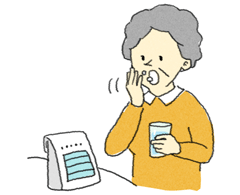
As a first step, it is important to deal with any arteriosclerosis risk factors such as smoking, high blood pressure, high cholesterol, diabetes, stress, and obesity by taking care to eat a balanced diet, getting adequate exercise, and, if you are a smoker, by giving up smoking. If that does not lead to an improvement, drug treatment may be prescribed in the form of medication such as an anti-platelet agent, which guards against arteriosclerosis.
Drug treatment is the most basic treatment method. The extent to which it is used varies according to the objective and severity, and can be effective in a wide range of cases from mild to severe (Table 4).
If the arteriosclerosis has progressed, surgical treatment may be performed. This may be surgery to create a bypass or a treatment called angioplasty in which a balloon is used to widen narrowed blood vessels.
Table 4: Symptom severity and examples of drugs used
| Severity | Objectives | Drugs used |
|---|---|---|
| Mild (coldness, numbness, etc.) |
|
Anti-platelet agent |
| Moderate (intermittent claudication) | Anti-platelet agent & vasodilator | |
| Following percutaneous transluminal angioplasty and stent placement |
|
Anti-platelet agent, anticoagulant |
| Severe (ischemic ulcers) |
|
Anti-platelet agent, anticoagulant and vasodilator |
The table below (Table 5) shows the main drugs used in the treatment of PAD. The action differs depending on the type of drug.
Table 5: Main therapeutic agents
| Therapeutic agent | Main action |
|---|---|
| Anti-platelet agent Drugs related to anti-platelet agents |
Improve blood flow by inhibiting the action of platelets, which are the cause of obstructions in the arteries |
| Anticoagulants | Improve blood flow by preventing blood from hardening |
| Peripheral vasodilators | Make it difficult for blood clots to form and improve blood flow by dilating blood vessels |
Physical therapy (ergotherapy)
This is a treatment method whereby different pathways (collateral circulation) that provide a bypass for blood flow are developed to increase blood flow to the feet/legs through muscular exercise such as fast walking or light jogging under the supervision of a doctor. This approach is used to ameliorate intermittent claudication. In Japan, this physical therapy is covered by national health insurance.
Bypass surgery (surgical treatment)
One surgical treatment option is to create an alternate pathway (bypass) around an obstructed artery by using synthetic blood vessels or the patient's own blood vessels to make new blood vessel connections so that blood will flow past the narrowed or obstructed artery (Figure 4).
Endovascular treatment (balloon, stent placement)
Recently, progress has been made in intravascular treatment, which treats vascular lesions through a tube called a catheter using angiography techniques. A catheter with a balloon attached is inserted into the narrowed or obstructed locations of an artery, and the balloon is inflated inside the blood vessel to widen it. When an adequate effect cannot be obtained with the balloon alone, a metallic tube called a stent may be inserted in the blood vessel at the same time (Figure 5).
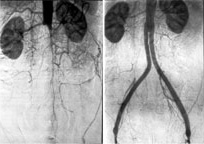
Photo: Hiroshi Shigematsu
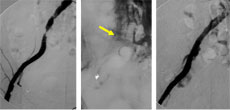
A fine tube called a catheter is passed through the blood vessels to the narrowed vessel. When it reaches the target location, a balloon is inflated to widen the blood vessel. Once the vessel is widened, a metallic tube called a stent is inserted and fixed in place to prevent the vessel from becoming obstructed again. The procedure, known as catheterization, takes about 30 minutes, produces only a small wound, and is low risk for the patient, and so nowadays is a common surgical treatment.
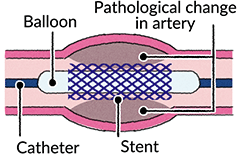
The narrowed location of the blood vessel is widened with a balloon, after which a catheter with a stent mounted on a balloon is inserted.
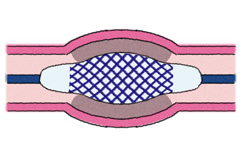
The balloon is inflated, expanding the stent.
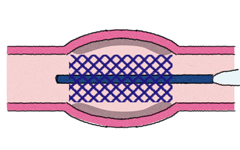
The balloon is deflated and the catheter removed, leaving the stent placed inside the blood vessel.






